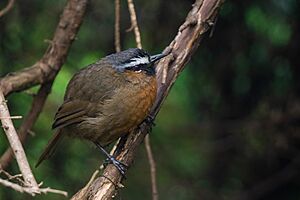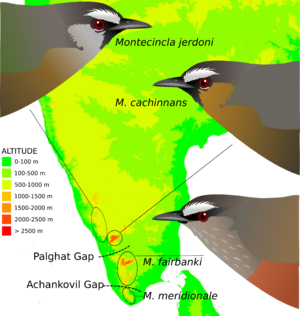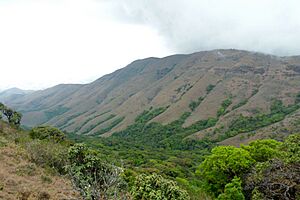Nilgiri laughingthrush facts for kids
Quick facts for kids Nilgiri laughingthrush |
|
|---|---|
 |
|
| Conservation status | |
| Scientific classification | |
| Genus: |
Montecincla
|
| Species: |
cachinnans
|
 |
|
| Synonyms | |
|
Garrulax cachinnans |
|
The Nilgiri laughingthrush (Montecincla cachinnans) is a special bird. It lives only in the high Nilgiri Mountains and nearby hills in Peninsular India. This bird is easy to spot because of its bright colors. It has a reddish-brown belly and olive-brown back. A clear white stripe above its eye and a black throat make it unique. You can often hear its loud, nasal calls, but it can be hard to see when it hides in thick bushes.
Contents
About the Nilgiri Laughingthrush
This bird's name has changed a few times over the years. Scientists use different names as they learn more about birds. The Nilgiri laughingthrush was first described by a scientist named Thomas C. Jerdon in 1839. He gave it the name Crateroptus cachinnans.
Later, scientists thought there might be two types of this bird. One was in the Nilgiris, and another was in the Brahmagiris and Wayanad areas. The one from Brahmagiris was called jerdoni. It had a grey upper chest. Today, jerdoni is seen as its own separate species, called the Banasura laughingthrush.
Recent studies looked closely at the birds' DNA. These studies showed that the Nilgiri laughingthrush was not closely related to other birds it was grouped with. Because of this, scientists created a new group, or genus, for it. This new genus is called Montecincla. So now, the bird's full scientific name is Montecincla cachinnans.
What Does the Nilgiri Laughingthrush Look Like?
The Nilgiri laughingthrush is about 24 centimeters (about 9.5 inches) long. Its belly is a reddish-brown color. Its upper body is a dark olive-grey. The top of its head is a slaty brown. It has a wide, white stripe above its eye, which is outlined in black. Its throat, the area around its eyes, and a line behind its eye are black. Its tail is olive-brown.
The bird's eyes are reddish-brown. Its legs and beak are black. The jerdoni type, which is now a separate species, has a grey upper chest. This bird is very easy to tell apart from other birds because of its unique colors.
Where It Lives and What It Does
The Nilgiri laughingthrush lives in thick forest patches. You can find it in the Nilgiri and Wayanad ranges. It prefers places higher than 1,200 meters (about 3,900 feet) above sea level.
These birds look for food along the edges of the forest. They usually search alone or in small groups. They often stay low in the trees or sometimes on the ground. They are most active in the early morning and late afternoon. They are also very noisy! One bird might make loud, rising and falling nasal calls. Another bird nearby might make sharp kek sounds.
They eat many different things. In winter, they drink nectar from flowers like Lobelia excelsa and Rhododendron. When Strobilanthes plants bloom, they also feed on their nectar and petals. They enjoy fruits from plants like Ilex species, Solanum auriculatum, and Rubus species (like blackberries). They also eat insects. They crush insects before swallowing them. Sometimes, they even catch small tree-frogs. If a fruit is too big, they hold it with their foot and tear it apart. They often look for food on the ground at dawn and dusk. During the day, they mostly pick food from plants.
Reproduction and Life Cycle
The Nilgiri laughingthrush builds its nests from February to early June. The nest is shaped like a cup. It is usually placed about 1 to 2 meters (about 3 to 6.5 feet) above the ground. They build it in thick bushes, often near a stream or a wet area at the edge of a forest patch. Both the male and female birds help build the nest.
The inside of the nest is lined with soft materials like hair. About half of the nest's weight comes from mosses. It takes about 5 to 18 days to build a nest. Nests built later in the season are often finished faster.
The female lays two greenish-blue eggs. These eggs have brown spots and streaks. The eggs are about 2.3 to 2.7 centimeters (about 0.9 to 1.1 inches) long. They are about 1.9 to 2.0 centimeters (about 0.7 to 0.8 inches) wide. Both parents take turns sitting on the eggs. The chicks hatch after 16 or 17 days. If one egg does not hatch, the parents leave it in the nest.
When the chicks are young, their parents feed them insects. Later, they also get berries like Rubus. The parents swallow the waste produced by the young birds to keep the nest clean. The young birds leave the nest after 15 to 18 days. But they stay close to their parents for about three more weeks. Birds that might eat the eggs or young include the Indian jungle crow and the greater coucal.
Conservation Status
The Nilgiri laughingthrush lives in a very small area. This area is at risk from changes to its natural home. Because of this, the Nilgiri laughingthrush is considered an endangered species. This means it needs our help to survive.






